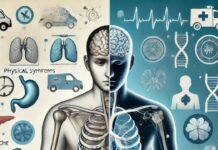A recent study found that women who have gone through menopause may have more white matter hyperintensities in their brains than premenopausal women or men of the same age.
Some types of memory loss or lapses can be caused by menopause, but they are very easy to treat. Scientists have known for a long time that estrogen and progesterone are linked to brain fog and menopause, but also Alzheimer’s. New studies on dementia and what happens to a woman during her childbearing years back up this idea.
The study’s results were written up in the journal “Neurology.”
White matter hyperintensities are small lesions that can be seen on brain scans. They happen more often as people get older or if they have high blood pressure that isn’t under control. Some studies have found that these biomarkers in the brain are linked to a higher risk of having a stroke, getting Alzheimer’s, or losing your mind.
“White matter hyperintensities get worse as the brain ages,” said study author Monique M. B. Breteler, MD, PhD, of the German Center for Neurodegenerative Diseases (DZNE) in Bonn, Germany, and a member of the American Academy of Neurology. Having white matter hyperintensities doesn’t mean a person will get dementia or have a stroke, but having more of them may make that more likely.
“Our study looked at what effect menopause might have on the amount of these biomarkers in the brain. Our results suggest that white matter hyperintensities change in different ways for men and women, and that menopause or other factors that affect when menopause starts, like differences in the aging process, are important.”
The average age of the 3,410 people in the study was 54. 58% of those people were women, and 59% of the women were past menopause. Also, 35% of all participants had high blood pressure, and of those, 50% had high blood pressure that couldn’t be controlled.
All participants had MRI brain scans. Researchers looked at the scans and counted how many participants had white matter hyperintensities. The average amount of these biomarkers in the brain was 0.5 milliliters (ml). Men had an average brain size of 1,180 ml and women had an average brain size of 1,053 ml. The area of the brain where white matter hyperintensities are found had an average total white matter volume of 490 ml for men and 430 ml for women.
After taking age and things like high blood pressure and diabetes into account, researchers found that postmenopausal women had more of these biomarkers in their brains than men of the same age. Postmenopausal women aged 45 and up had an average total white matter hyperintensities volume of 0.94 ml, while men had an average total white matter hyperintensities volume of 0.72 ml. Researchers also found that biomarkers in the brain increased faster with age and more quickly in women than in men.
There was no difference in the average number of white matter hyperintensities between women before menopause and men of the same age.
Researchers also found that women who had gone through menopause had more white matter hyperintensities than women who had not gone through menopause but were the same age. In a group of people ages 45 to 59, the average total volume of white matter hyperintensities in postmenopausal women was 0.51 ml, while it was only 0.33 ml in premenopausal women.
There was no difference between women who used hormone therapy before or after menopause. Breteler said that this finding suggests that hormone therapy after menopause may not protect the brain.
Regardless of whether they were menopausal or not, women with uncontrolled high blood pressure had more of this biomarker in their brains than men did.
“It has been known for a long time that high blood pressure, which affects the small blood vessels in the brain, can cause more white matter hyperintensities,” said Breteler. “The results of our study not only show that more research needs to be done to find out how menopause may affect the health of the brain’s blood vessels. They also show how important it is to take into account the different health paths of men and women and whether or not they have gone through menopause. Our research shows how important it is for older women, especially those who have risk factors for vascular disease, to get treatment that is tailored to their gender and needs.”














![Technical Aspects of 844 Area Code in 2024 [Detail Guide] 844 Area Code](https://articleify.com/wp-content/uploads/2024/01/844-Area-Code-150x150.jpg)














